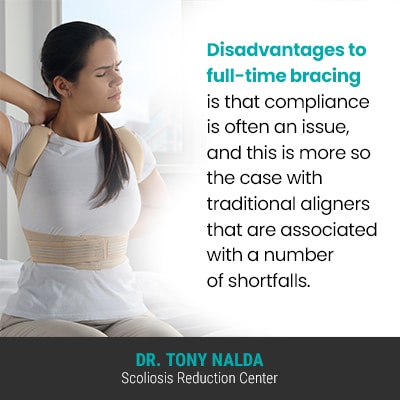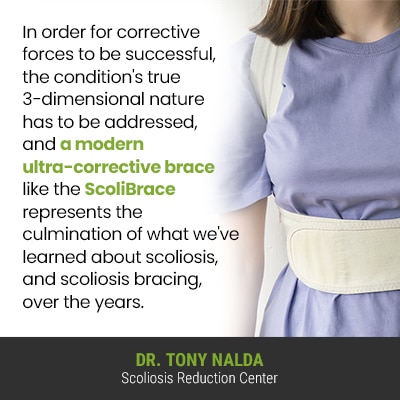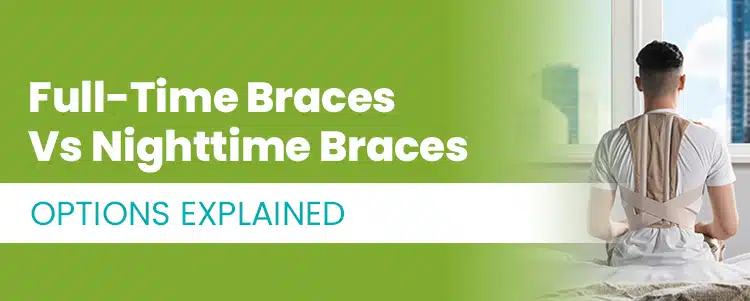Scoliosis braces are particularly effective on growing spines so are a common facet of treatment for childhood scoliosis, and when it comes to potential brace efficacy, compliance is key; no brace will be effective if it isn’t worn exactly as prescribed, and that includes full-time, nighttime braces, and/or corrective braces.
Just as there are different treatment approaches for addressing scoliosis, there are different types of scoliosis braces used as a facet of treatment. There is also an important distinction to be made between traditional scoliosis bracing and modern corrective bracing.
Let’s start by exploring the different scoliosis treatment approaches as they favour different types of scoliosis braces.
Scoliosis Treatment Approaches: Traditional vs Conservative
Understanding the different scoliosis treatment approaches helps make the distinction between traditional aligners and modern aligners clear.
Traditional treatment was the dominant choice for many years, but that doesn’t mean it’s the best, nor only scoliosis treatment option available.
Traditional treatment has the goal of stopping progression; as a progressive condition, scoliosis has it in its nature to get worse over time, while conservative treatment has the ultimate goal of managing progression by correcting scoliosis.
Correcting scoliosis means impacting it on a structural level. As a structural spinal condition, the unnatural sideways-bending and rotating spinal curve involves a structural abnormality within the spine itself.
Conservative treatment is also known as chiropractic-centered because it uses a number of techniques and manual adjustments to work towards adjusting the position of the curve’s most-tilted vertebrae at its apex; when successful, the vertebrae can be adjusted back into alignment with the rest of the spine.
Once structural results are accomplished in the form of a curvature reduction, I can shift the focus to increasing core strength so the spine’s surrounding muscles can optimally support and stabilize it.
Corrective bracing can help achieve corrective treatment results by pushing the spine into a straighter alignment, and when combined with other types of treatment, scoliosis can be impacted on every level for true corrective results.
When it comes to traditional treatment, patients are commonly funnelled towards spinal fusion surgery, and the goal of traditional bracing is not to correct a scoliosis, but to simply stop the condition from getting worse.
When it comes to bracing as a facet of scoliosis treatment, the process and concept is similar to that of orthodontic treatment that uses braces and/or an Invisalign to straighten teeth; the same can be said of scoliosis braces that work by applying pressure to the spine to alter its position over time.
Let’s start our exploration of the difference between full time braces and those worn at nighttime.
Full-Time Scoliosis Bracing
The most common type of scoliosis brace used in traditional treatment is the Boston brace, and this is commonly prescribed for full-time wear which can mean anywhere from 18-23 hours a day for up to five years.
Braces for childhood scoliosis generally need to be worn until growth has stopped as growth is the main trigger for scoliosis progression.
Each case of scoliosis is unique, which is why treatment plans have to be fully customized to address key patient/condition variables.
Factors such as patient age, condition type, curvature location, and severity all shape the design of treatment plans and a patient’s experience of life with scoliosis.

Disadvantages to full-time bracing is that compliance is often an issue, and this is more so the case with traditional aligners that are associated with a number of shortfalls.
The Boston brace, for example, was designed in the ’70s, and despite what we have learned about scoliosis and treatment efficacy over the years, its design remains unchanged.
The Boston is made from rigid material and is mass produced; while some measurements are involved, the Boston isn’t fully customized to suit the specifics of a patient’s body and curvature type the way modern corrective bracing is.
The Boston works via a three-point-pressure system that uses corrective pads to squeeze the spine at certain locations along the curve to force it into a straighter position, but the issue with this is that squeezing the spine can actually weaken it over time; scoliotic spines are already facing a number of challenges that involve weakness, rigidity, and adverse spinal tension.
Full time braces, particularly traditional braces, have low compliance rates, meaning patients aren’t wearing the brace as prescribed, limiting its potential efficacy; the main type of scoliosis is adolescent idiopathic scoliosis, diagnosed between the ages of 10 and 18.
Adolescents generally want to blend in, they don’t want to look different from their peers, and wearing a bulky traditional scoliosis brace isn’t aligned with that.
Part of the reason nighttime braces evolved was to improve compliance as young patients only had to wear the brace at night.
Nighttime Aligners
Night only aligners such as the Charleston bending brace are designed to help young patients reduce their thoracolumbar scoliosis during sleep; this was developed to address the compliance issue that limited the Boston’s potential efficacy.
If a brace is bulky, uncomfortable, and noticeable, it’s unlikely that the very age group they are supposed to help, adolescents, will wear it full time as prescribed; instead, these braces are being taken off at school and left in lockers, or left at home entirely.
No brace can work if it’s not being worn as prescribed, and to be clear, no brace on its own can correct a scoliosis, but when combined with other forms of treatment, it can help augment corrective forces for the best results.
A nighttime brace like the Charleston bending brace facilitates pelvic manipulation to simulate the effects of lumbar spinal curvatures; the brace molds to the body while in a position of bending towards the outward edge of the scoliotic curve to overcorrect the unnatural spinal curve.
While a nighttime brace can address the issue of compliance that’s more common in the prescription of braces to be worn full time, the true efficacy of night-time braces can also be questioned because they only address the bend of the curve, not its rotation.
In essence, braces like the Boston brace and the Charleston bending brace are already limited in their potential efficacy because they only address the unnatural bend in the spine, but not its rotational component, so they are addressing scoliosis as a 2-dimensional condition, when rotation makes it a complex 3-dimensional condition.
There are other nighttime aligners such as the Providence brace and the Wilmington brace, but like the Boston brace, compliance issues and only addressing the condition as 2-dimensional limit their potential efficacy; fortunately, modern corrective bracing evolved out of the need for a different type of scoliosis brace.
Corrective Bracing

So scoliosis brace options include braces that need to be worn full time such as the Boston, or nighttime braces that include the Charleston, the Providence brace, and the Wilmington brace, but none of these options offer corrective potential.
In order for corrective forces to be successful, the condition’s true 3-dimensional nature has to be addressed, and a modern ultra-corrective brace like the ScoliBrace represents the culmination of what we’ve learned about scoliosis, and scoliosis bracing, over the years.
In addition, the design of the ScoliBrace addresses many of the shortcomings associated with traditional aligners.
The ScoliBrace doesn’t squeeze the spine unnaturally, but instead pushes it into a corrective position so the spine isn’t weakened over time, and in addition, the ScoliBrace addresses the condition’s rotational component, and each brace is bespoke to its wearer; state-of-the-art computer software and technology is applied to ensure that braces are fully customized to address the specifics of a patient’s body/curvature type.
To treat scoliosis effectively without surgery, corrective bracing can complement condition-specific chiropractic care and physical therapy so that curvatures can be reduced on a structural level, and just as orthodontic care can help straighten teeth by applying pressure over time, so too can a scoliosis brace help push the spine into a healthier position.
Conclusion
What patients need to understand about scoliosis is that as a progressive condition, where a patient’s scoliosis is at the time of diagnosis doesn’t mean that’s where it will stay; only proactive treatment can work towards counteracting the condition’s progressive nature.
To treat scoliosis successfully, a scoliosis brace can help augment corrective treatment results, but the type of brace recommended will depend on the type of scoliosis treatment approach that’s chosen.
Traditional scoliosis treatment that funnels patients towards surgery will recommend traditional aligners such as the Boston, a full time brace, and/or nighttime aligners such as the Charleston bending brace, the Wilmington brace, and the Providence brace.
Traditional full time and nighttime aligners, however, are limited in their potential efficacy in terms of actual correction because their goal is to stop progression, not to correct the scoliosis; this complements the goal of spinal fusion surgery.
Modern corrective bracing like the ScoliBrace has corrective potential because it addresses the condition’s true 3-dimensional nature, while improving compliance rates through its highly-customized design that makes braces less bulky, more comfortable, and easier to take on and off.
A corrective brace can apply stronger forces because as part of modern conservative treatment, it’s combined with other treatment disciplines that also offer corrective potential.
Here at the Scoliosis Reduction Center®, my patients benefit from a modern conservative treatment approach that integrates multiple condition treatment disciplines to achieve corrective treatment results, and particularly when it comes to treating adolescent idiopathic scoliosis, modern corrective bracing plays an important part.




